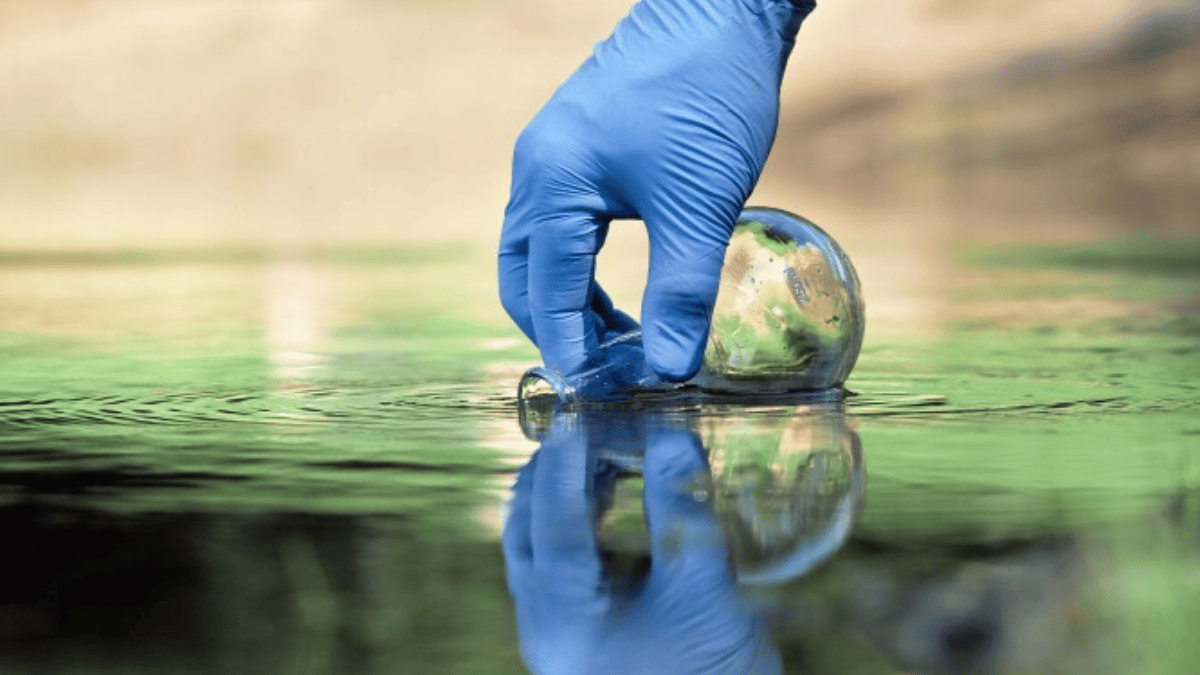Scientist Discusses Drinking Water Contamination – West Virginia Public Broadcasting
Scientist Discusses Drinking Water Contamination West Virginia Public Broadcasting


Tap Water Testing Reveals High Levels of PFAS Contamination in New Martinsville

Earlier this week, tap water testing conducted in 18 states by the Environmental Working Group (EWG) found New Martinsville had the second-highest level of PFAS in the country at 40 parts per trillion.
Introduction
PFAS, commonly known as “forever chemicals,” are manmade chemicals used in various industrial processes and consumer products. However, they persist in the environment and pose a risk to human health.
In an interview with EWG Senior Scientist Tasha Stoiber, she discussed water contamination, its health risks, and potential solutions.
This interview has been lightly edited for clarity.
Background
Schulz: Tell me what the Environmental Working Group is and what they do.
Stoiber: We are a nonprofit research and advocacy organization with offices in D.C., California, and Minnesota. Our mission is to empower people to make healthier choices in their lives. We conduct research, outreach, and education to reduce chemical exposures in daily life.
Schulz: What do you focus your research on?
Stoiber: I work on various areas, including drinking water contaminants in the U.S., such as PFAS and hexavalent chromium. I also study chemicals in consumer products, like PFAS in mattresses and food additives. My portfolio is wide, but I spend a significant amount of time researching chemicals in drinking water and the filters that remove them.
Schulz: Can you give me an idea of the contaminants people have historically been concerned about in their water and what the concerns are today?
Stoiber: There are numerous drinking water contaminants, some regulated and some unregulated. Our focus is on getting regulations in place for unregulated contaminants. The process for setting drinking water regulations in the U.S. is lengthy and inefficient, resulting in outdated regulations. For example, lead has received attention due to contamination issues in certain cities, but it is largely an infrastructure issue. Many people assume their tap water is safe because it comes from a public utility, but there are unregulated contaminants and outdated regulations that may not adequately protect against health risks.
Water Contamination and Safe Limits
Schulz: I briefly looked at your website and was surprised by what I saw regarding my local provider. Why does EWG differentiate between legal and safe limits?
Stoiber: Our tap water database compares EWG’s standard for drinking water contaminants to legal limits. The gold standard would be limits solely based on protecting health, which are often lower than the federal legal limits. Many of these standards are based on California’s public health goals or EPA’s IRIS assessments. Legal limits may not be as protective as they could be based on current scientific findings.
Persistent Organic Pollutants (POPs) and PFAS
Schulz: What is PFAS, and why is there so much focus on it now?
Stoiber: PFAS is a family of thousands of chemicals with carbon and fluorine bonds. They are used in various products due to their stain, water, and grease resistance. These chemicals persist in the environment and end up in drinking water, soil, and air, posing a risk to human health. PFAS, also known as Teflon chemicals, have been used for decades. While some legacy PFAS chemicals have been phased out, they have been replaced by similar persistent chemicals. The focus on PFAS has increased due to its widespread contamination, recent testing data, and the proposal for new maximum contaminant limits (MCLs) by the EPA.
Schulz: Can you explain the EPA’s proposal for MCLs in layman’s terms?
Stoiber: The proposal includes MCLs for six types of PFAS, including PFOA and PFOS, as part of a mixture. The MCLs for PFOA and PFOS would be four parts per trillion. However, the goal is zero because these chemicals are linked to cancer. The legally enforceable MCL would be four parts per trillion due to detection limits.
Recommendations for Individuals
Schulz: What filters do you recommend for individuals?
Stoiber: We recommend filtering drinking water at home using either granular activated carbon or reverse osmosis filters. These filters can significantly reduce PFAS exposure. Activated carbon filters are more cost-accessible, while reverse osmosis filters are more expensive and require plumbing installation. It’s important to change filter cartridges on time for efficient filtration. Filtering drinking water is a short-term solution, but the long-term solution lies in federal regulations and reducing the use of these chemicals.
Stoiber: The burden of addressing this issue should not fall on individuals or communities. The responsibility lies with the polluters who have profited from these chemicals. Long-term solutions involve federal regulations and minimizing the use of PFAS in commerce to prevent further contamination.
SDGs, Targets, and Indicators
1. Which SDGs are addressed or connected to the issues highlighted in the article?
- SDG 6: Clean Water and Sanitation
- SDG 3: Good Health and Well-being
- SDG 12: Responsible Consumption and Production
The article discusses the issue of water contamination, specifically the presence of PFAS (forever chemicals) in tap water. This relates to SDG 6, which aims to ensure availability and sustainable management of water and sanitation for all. Additionally, the article mentions the health risks associated with PFAS exposure, connecting it to SDG 3, which focuses on promoting good health and well-being. Lastly, the article mentions the need to reduce the use of these chemicals in commerce, aligning with SDG 12, which aims to ensure sustainable consumption and production patterns.
2. What specific targets under those SDGs can be identified based on the article’s content?
- SDG 6.3: By 2030, improve water quality by reducing pollution, eliminating dumping and minimizing release of hazardous chemicals and materials.
- SDG 3.9: By 2030, substantially reduce the number of deaths and illnesses from hazardous chemicals and air, water, and soil pollution and contamination.
- SDG 12.4: By 2020, achieve environmentally sound management of chemicals and all wastes throughout their life cycle, in accordance with agreed international frameworks, and significantly reduce their release to air, water, and soil in order to minimize their adverse impacts on human health and the environment.
Based on the article’s content, the targets mentioned above are relevant. Target 6.3 focuses on improving water quality by reducing pollution and minimizing the release of hazardous chemicals, which directly relates to the issue of PFAS contamination in tap water. Target 3.9 aims to reduce deaths and illnesses caused by hazardous chemicals and pollution, which is relevant considering the health risks associated with PFAS exposure. Target 12.4 addresses the need for environmentally sound management of chemicals and reducing their release to minimize adverse impacts on human health and the environment.
3. Are there any indicators mentioned or implied in the article that can be used to measure progress towards the identified targets?
- Presence and levels of PFAS in tap water
- Number of drinking water regulations for unregulated contaminants
- Percentage of taps with PFAS detections
- Compliance with proposed MCLs for PFAS
- Number of households using drinking water filters
The article mentions several indicators that can be used to measure progress towards the identified targets. The presence and levels of PFAS in tap water can be monitored to assess water quality and progress towards reducing pollution (target 6.3). The number of drinking water regulations for unregulated contaminants can be tracked to determine if new regulations are being established (target 6.3). The percentage of taps with PFAS detections can indicate the extent of contamination and progress in addressing it (target 3.9). Compliance with proposed MCLs for PFAS can be monitored to ensure the reduction of hazardous chemical exposure (target 3.9). Lastly, tracking the number of households using drinking water filters can provide insights into consumer actions towards reducing exposure to PFAS (target 12.4).
SDGs, Targets, and Indicators Table
| SDGs | Targets | Indicators |
|---|---|---|
| SDG 6: Clean Water and Sanitation | Target 6.3: By 2030, improve water quality by reducing pollution, eliminating dumping and minimizing release of hazardous chemicals and materials. | – Presence and levels of PFAS in tap water – Number of drinking water regulations for unregulated contaminants – Percentage of taps with PFAS detections |
| SDG 3: Good Health and Well-being | Target 3.9: By 2030, substantially reduce the number of deaths and illnesses from hazardous chemicals and air, water, and soil pollution and contamination. | – Presence and levels of PFAS in tap water – Compliance with proposed MCLs for PFAS |
| SDG 12: Responsible Consumption and Production | Target 12.4: By 2020, achieve environmentally sound management of chemicals and all wastes throughout their life cycle, in accordance with agreed international frameworks, and significantly reduce their release to air, water, and soil in order to minimize their adverse impacts on human health and the environment. | – Presence and levels of PFAS in tap water – Number of households using drinking water filters |
Behold! This splendid article springs forth from the wellspring of knowledge, shaped by a wondrous proprietary AI technology that delved into a vast ocean of data, illuminating the path towards the Sustainable Development Goals. Remember that all rights are reserved by SDG Investors LLC, empowering us to champion progress together.
Source: wvpublic.org

Join us, as fellow seekers of change, on a transformative journey at https://sdgtalks.ai/welcome, where you can become a member and actively contribute to shaping a brighter future.







